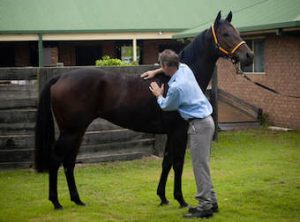


A full body treatment for any horse incorporates:
muscle re-education,
a reduction of the bio-electrical impulse of the nervous system,
joint mobilisation, and
improved functioning of the body systems.
All this adds up to restoration of muscle and neurological memory. This is the most powerful form of natural therapy there is for horses available. That is backed up by scientific evidence within the boundaries of tangible possibility.

Horses really respond to touch. If you start lightly it creates a good contact. Then the horse builds up trust with you and you can proceed to apply more pressure and start to release some fascia straight away. In this photo here, I have made my contact and start to apply a bit more pressure. When there is a good focus, there is a good connection every time.

Horses love their shoulders being worked on. A feel good circular vibration with the hand always goes down well with every horse. Shoulder muscles work hard and help propel the horse forward. There are big superficial muscles like the trapezius that cover a lot of area, from the crest-mid neck to the start of the horses back, down to the bottom end of the shoulder-blade. The deeper muscles are underneath and sit on top of the scapula bone (or shoulder-blade) itself. if you ever need to relax a ‘nervy’ or unpredictable horse, just massage the shoulder and in particular right on top of the shoulder-blade.
The horses back is usually the most obvious part of its anatomy that has to be looked at. But, they get tight all over! The neck is always going to need a look at. When a horse has a bit in its mouth, and we put tension on the reins, muscles can start top tighten up from this. But I would like to point out , as soon as we put a bit in their mouth the TMJ ( temporal mandibular joint) is the first place to feel it. I have seen a lot of base of skull/poll and TMJ issues over the years. Usually racehorses, hard working competition horses, or a horse just carrying a for bit for a long time.


